Onions Bashkir sevka names of varieties. The best varieties of onions
Arzamas local
Mid-season, srednegnezdny, round-cubed bulb with amber-ocher color of dry scales, weighing 30–78 g. Recommended for cultivation in the middle belt of the country.
Bessonovsky local
Early ripening, srednegnezdny, bulb roundly flat or rounded flat with running upwards with yellow color of dry scales, bulb weight 35–46 g. 78 g. Recommended for cultivation in the middle belt of the country.
Mstersky local
Early ripe, small-creeped, onion is rounded flat with yellow color of dry scales.
Onion Pogarsky local improved
Pogarsky onion variety is early-ripening, medium and multi-crib, onion is flat or rounded-flat with up and down runoff, dry yellow scales of various shades, onion weight is 29-50 g.
Rostov onion local
Early ripening, medium - and mnogopnezdny, bulb flat or rounded flat, sometimes rounded flat with running up, dry scales are yellow, the mass of onion bulbs Rostov onion 30-57 g.
Spassky onion local improved
Mid-seasoned spassky onion, medium and multi-nest, bulb flat or round-flat, dry yellow scales with a brown tinge, bulb weighing 40–52 g
Timiryazevsky onions
Early ripe, sparsely bulbous, bulbous, rounded-flat, with slight upturning, dry scales light brown, sometimes golden yellow, around the neck with a gray tinge, onion mass 49–70 g.
Bow Stuttgarter Riesen
German variety, early ripe, small-nest. Gardeners speak of onions Stuttgarter Riesen well.
Semi-varieties of bulb onions
Onion Danilovsky 301
Mid-season, sparse, flat or rounded flat bulb, dry scales dark red with violet shade and violet, Danilovsky onion mass is 80 - 155 g.
Vishensky local
Variety of national selection of the Nizhny Novgorod region. According to the description, it is similar to the Danilovsky 301 variety, but the color of its dry scales is lighter — pink-red with a dark purple hue. Bulbs are larger, the variety is small-sized.
Myachkovsky 300
Mid-season, small-creep, flat or rounded flat bulb, dry yellow scales, bulb mass 40 - 120 g
Odintsovtsy
Mid-season, sparsely bulbous, flat and rounded flat bulb, color of dry scales golden yellow, bulb mass 55–80 g
Kaba (yellow)
Late-ripening, small-creeped, onion, rounded and rounded-flat with running down (cast iron), weighing 80-140 g, dry scales are yellow. Iris. Early ripe, small-creep, round bulb, scales yellowish brown and straw yellow, bulb mass 35–86 g.
Krasnodar G-35
Small-sized, onion is round or round-oval, the color of dry scales is yellow, sometimes with a pink tinge. Bulb weight 115 g
Sweet Onion Varieties
Sweet varieties of bulb onions are grown in the annual crop in the southern regions of the country (southern regions of the Volga region, the North Caucasus). In the middle lane, they can be grown only through seedlings. Spanish 313, Orange, Polish variety - Kutnovska. Dutch hybrids are noteworthy for gardeners:
Spring onions are a storehouse of vitamins that we need so much in the spring. As soon as the sun warms up, I immediately wake up my appetite for everything green: dill, parsley, onions, I really like garlic feathers - the taste is excellent, fragrant, fragrant, but not so bitter yet. I recently discovered shallot.
Previously, she planted only our usual seedling on a feather. But now I always grow this vegetable, I liked it so much. The benefits of shallot are huge:
- Onions for ascorbic acid, it is contained much more than in the bulb. 70% of vitamin C is found in green leaves (feathers).
- Shallot contains flavonoids, which have anti-inflammatory properties, are good prevention of the formation of cancer.
- Onions are rich in vitamins B1, B2, C, PP, sugars and carotenoids.
- The shalote contains minerals: nickel, vanadium, cobalt, chromium, molybdenum.
- The bulbs contain potassium, which is so necessary for our heart.
Onion shallot tender and juicy in taste. The bulbs are small in comparison with bulb, but he has a high-quality green feather, which is well kept even in the conditions of an apartment. Variety Description Shallot belongs to the onion family.
By the way, onions are considered to be one of the most ancient cultures, the ancient Greeks endowed the onion with magical properties. Shallots have many names: squash, forty-shrub, family. The bulbs are small in size, basal in the first year. Color from white to purple.
The leaves are thick, hollow, 20 - 45 cm tall. The best predecessors for onions: pumpkin, legumes, green mans, green. In early-ripening varieties, the growing season is 50-60 days! Green shallot onions are more demanding than onions, but it also has more benefits.
Seeds are sown in the spring when only the snow thaws. After 20-25 days, a green fragrant feather will appear that can be cut. Onions are harvested after 2, 5 - 3 months (depending on the variety) after planting.
Do not be afraid, shallot is very frost-resistant, tolerates lowering the temperature to -10…-15 degrees! Even the frozen onion will germinate and yield a harvest. This variety of onions is growing quite quickly, and root system he is small
Therefore, for the cultivation of shallot is better to choose sunny places with light, loose and fertile soil. Heavy and wet land does not suit him. Selection of planting material As they say "size matters."
For growing and planting, choose only healthy shallot bulbs with tight, dry, crack-free scales at the bottom.A large onion weighs about 40 grams. From large specimens grows more lush green, as well as more children in the nest.
Such bulbs have better health, less likely to get sick with a viral disease. Small shallot bulbs are about 10-15 grams, increase fewer bulbs in the nest (about 3-5), but they have more space to develop and will be larger. When you plant onions, you do not need to cut the upper part, as we do with the seedling. Trimming "shoulders" accelerates the growth of the green feather. But for this particular variety, it is more important that the growth of the roots is ahead of the growth of the leaves, and this happens better without pruning.
Shallots - planting scheme
Landing Onions can be planted as soon as the snow melted and until the beginning of May, later there is no point, the plant will not have time to develop normally. Landing scheme: Small shallot onions (10 - 15 g): planted every 8 - 10 cm, medium (15 - 25 g) - after 15 - 18 cm, large (30 - 40 g) - after 20 - 30 cm with a distance between rows 30 - 40 cm. If you can allocate a lot of land for planting onions, you can grow squarely - in a nesting way - 20 x 20, 30 x 30 or 40 x 40 cm. Frosts before planting are well watered.
The bulbs deepen by 5 - 6 cm. If planted too small - it can bulge out of the ground, and deep ones just slow the emergence of shoots that we need. (I recall the root system should be ahead of the growth of greenery). The root system in shallot is weak, so loosening and weeding are required.
The onions like abundant watering especially during the growth of greenery and drought. The growing season of shallot is small, therefore it is fed in May and June. You can make organic: insulin mulle infusion 1:10 or bird droppings 1:15.
You can make a complex mineral fertilizer (30 - 40 g. Per 10 liters. Per 1 sq. M.) July dressing is not as effective as in May for onions. Nitrogen fertilizers are now generally NOT available - they worsen the maturation and preservation of the bulbs.
Growing a good turnip: In order for the Shallot turnip to grow larger, a nest is formed at the beginning or middle of July — to do this, carefully dig the ground from the onion, so that the onion can be seen and the small ones are removed along with the feather, leaving only 4 - 5 of the strongest. break out at a height of no more than 10 cm, otherwise they will continue to grow. Shallot varieties Ear ring - Early ripe variety resistant to bolting.
From 4 to 10 bulbs are formed in the nest. Onion medium size, spicy to the taste. Vitamin Basket - Early ripe variety. Onions taste spicy, onions 30 g., Feather - juicy, well kept for up to 10 months.
From germination to cutting a green feather - from 19 to 22 days, before harvesting the bulbs 65 - 70 days. SIR 7 - Early variety. From germination to cutting 32 - 34 days, before harvesting bulbs 60 - 70 days.
Onions weighing 25 - 30 g Emerald - Early ripe onion variety with rounded bulbs weighing 18 - 22 g, in a nest of 3-4 pieces. It tastes semi-sharp! Stored up to 10 months.
Varieties of onion for the Urals
Sofia GusevaLuk
I want to tell you about the variety onions for the Urals. These varieties are included in the state register of the Russian Federation and tested, tested specifically for our climate and light zone. Because different regions receive different amounts of light and heat.
The Urals region includes Kurgan, Chelyabinsk, Orenburg regions and Bashkiria. In the description all regions for which these varieties of onions are suitable will be indicated. In order not to list them each time, I will mark them with numbers, as in the registry:
- Northern - Murmansk, Arkhangelsk regions. Komi Republic, Karelia. Northwestern - Kaliningrad, Vologda, Kostroma, Novgorod, Leningrad, Pskov, Yaroslavl, Tver regions. Central - Vladimir, Bryansk, Kaluga, Ivanovo, Ryazan, Moscow, Tula, Smolensk regions. Volgo - Vyatka - Kirov, Sverdlovsk, Nizhny Novgorod regions. Republic of Mari El, Chuvash, Udmurt, Perm Territory. Central Black Earth - Voronezh, Belgorod, Lipetsk, Kursk, Tambov, Oryol regions. North Caucasus - Krasnodar, Stavropol Territories, Rostov Region, Republic of Adygea, Karchaevo-Cherkesskaya, Kabardino-Balkaria. Middle Volga - Samara, Penza, Ulyanovsk regions. Republic of Mordovia, Tatarstan. Lower Volga - Volgograd, Saratov, Astrakhan regions. Republic of Kalmykia. Ural - Orenburg, Kurgan, Chelyabinsk regions, Republic of Bashkortostan. West Siberian - Altai Republic. Novosibirsk, Kemerovo, Omsk, Tyumen, Tomsk regions, Altai Krai, Khanty-Mansi Autonomous Okrug. East Siberian region - Chita, Irkutsk regions, Krasnoyarsk Territory. Republic of Sakha, Tyva, Buryatia, Khakassia. Far Eastern - Kamchatka, Amur, Sakhalin, Magadan regions. Khabarovsk, Primorsky Krai.
Onion varieties for the Urals with photos and descriptions
Arzamas
This is an old, well-known, time-tested variety of national selection for cultivation in a two-year culture, through sevok. Bulb from elongated-rounded to cubical-rounded. The sizes are average, weighing from 40 to 80 grams.
The variety is zoned in the Gorky (now Nizhny Novgorod) region in 1943. The average ripening period is from 100 to 110 days. Medium-wheel, low-fat.
Perhaps growing to large bulbs in one year. The color of the scales is dark yellow, even with a brown tint; the scales inside are white, juicy, dense. Ripens before harvesting up to 96%. It is well stored in the winter. Regions of cultivation - 1, 2, 3, 4, 5, 7, 8, 9.
Bessonovsky local
Early multiyear acute variety. It can be grown in one-year, and two-year culture. Rounded flat bulb, dense, outside scales yellow, inside white.
Bulbs grow weighing 36-55 grams. From the germination of the first feathers on the set to their lodging takes 60-80 days. Longevity is good, can be stored almost until the spring - 8-9 months. Suitable for regions - 4, 5, 7, 8, 9, 10, 11, 12.
Buran
Late-ripening variety. The bulb grows single-toed, three-germ. Designed for growing two-year cycle. Universal grade, with a sharp vkusy.
Bulbs dense, rounded, weighing 67-100 grams. Dry scales bright yellow with anthocyanin, juicy - white. Yield up to 12 tons per hectare. Before harvesting, maturity is about 63%, and after ripening - 89.2%. Keep well.
May suffer from perenosporosis. Yields stable with large flat bulbs, with good keeping quality, resistant to bacterial diseases. I did not find this variety in the State Register for 2015. Apparently, already excluded, but he continues to live, as a local variety, spreading by local gardeners. Central, Middle Volga, Ural regions.
Botherus
The variety is medium early. Grown in one year from Chernushki and in a two-year culture. Large flat rounded bulb, weighing 60-80 grams. Outside the scales are yellow, inside are white. Spicy taste.
Before harvesting the variety matures by 85%, after ripening by 97%. Suitable for winter storage. Growing regions - 3, 9, 10 .
Moldavian
Mid-season breeding variety of the Transnistrian NIISH for cultivation in one season. When planting sevka for the second year goes to the arrow. Ripens in 105-110 days. Flat-rounded or rounded onions, weighing from 70 to 130 grams, under good conditions, up to 200 grams and more.
Outside, the scales are pink-brown with a white-purple hue, and inside - pale-purple. Two-chetyrehchatachkovye. Universal purpose, spicy taste. The average yield of 25-38 tons per hectare.
Myachikovsky 300
Early variety from full sprouting from sevka to lodging of a feather passes only 80-90 days. Medium density, flat or onion, weighing up to 110 grams. On top of the scales are yellow, and inside - white. Low-grade variety, multi-purpose, semi-sharp taste.
Well kept in winter. Suitable for cultivation by seeds for one year. Recommended for cultivation in the regions - 2, 3, 4, 7, 8, 9.
Red baron
The variety is suitable for cultivation, as seeds in one season, and Sevka for two years. The bulbs are dark purple completely, both from above and inside. The period from the first green feathers to their lodging is 95 days. Rounded flat bulb weighing up to 120 grams, semi-sharp taste.
The yield is usually 1.5 kg / m. Onion scales are dense, strong, recommended for long-term storage. Suitable for growing in regions - 3, 4, 5, 6, 9.
Siberian Annual
Superearly variety. When planting from sevka ripen for 60-70 days! If grown from seed, then on a 90-100 day! A lot of green, feather blue-green color. Flat or flat-round bulb, yellow.
Semi-sharp taste. The weight of the bulb grown from the seed reaches 200 grams, from seeds with an annual crop of up to 100 grams. The variety "Siberian Annual" is well stored, resistant to leveraging. Suitable for cultivation by region – 4, 9, 10.
Strigunovsky local
Early sharp variety. Suitable for cultivation for the year and the biennium from the sevka. Dense bulb is roundish, chetyrehchatchatka, weighing 45-80 g. Outside the scales are yellow with a grayish or pink shade, inside are white. The variety is valued for its good winter maintenance.
Through sevka, the variety ripens for 80-90 days, from seeds when sown in early spring or before winter - for 110-130 days. Suitable for cultivation in all regions of the Russian Federation.
Black Prince
Mid-season variety (100-105 days), created VNIISSOK. Suitable for sowing before winter and in early spring (one-year) and growing through onion sets (two-year). Rounded, dense onions, weighing 60-100 g. Purpose is universal. The scales are dark purple.
Two-three-wheeled, low-graded variety, of semi-sharp taste. Productivity up to 50 tons / ha. Longevity is good. Recommended for regions - 3, 4, 9, 10.
Exibichen
Medium late grade. Very fruitful, cold-resistant variety designed to obtain full onions in the annual crop. Valued for high yields in different climates.
Beautiful, dense oval bulbs grow up to 800 g during the summer. The upper scales are straw-colored, white inside. Surprisingly juicy, sweet variety. It is resistant to diseases. Suitable for growing in all regions of the Russian Federation.
Timiryazevsky
The old variety, which is no longer in the state register, but it lives in gardens. Zoned in 1968. Early, low-fat, low-starter. Designed for growing from seed in a two-year culture.
Flat-rounded onion, dense, spicy taste, weighing 50-70 grams. Outside the scales are light brown, sometimes yellow, inside are white. Maturation depends on the weather from 65% to 100%.
The storage quality is good up to 95%. Suitable for growing in non-black earth regions: Ural, East and West Siberian, Volga-Vyatka.These are all varieties that I found in the State Register for cultivation in the Urals. There are more hybrids there, but I do not plant them myself and I will not recommend it to my readers.
The best varieties of onions "not for the Urals"
Is there some more popular varietieswhich, despite the registers and recommendations of the academicians, the gardeners of the Urals grow on their plots. They spread themselves, thanks to their popularity.
Danilovsky 301
"Agrofirm Aelita" and VNIISSOK. Mid-season variety, low-fat, low-starter. From the mass appearance of green leaves at the sevka to lodging takes 90-100 days.
The bulb is flat-rounded and flat, weighing from 80 to 160 grams, spicy taste. Outside, the scales are dark red with a violet tinge or violet, and inside - light violet.
The yield of varieties of seedlings from 12 to 33 tons / ha. Recommended for cultivation in the regions - 2, 3, 4 . The variety is popular in the northern regions with a short summer.
Karatal
Selection of the Kazakh Research Institute of Agriculture. Early variety, ripening for 109 days. Recommended for cultivation as one-year. The bulb is usually round, sometimes flat, dense, weighing 120 grams.
Small onion. The average yield is 4.4 kg per meter. The scales outside are golden yellow and the inside is white. The grade of pleasant semi-sharp taste, is intended for the use fresh and for processing. His balance is satisfactory - a C grade.
The variety is stable, productive, with large bulbs of good quality . Onions are intended for cultivation in one year from seeds. Recommended for regions - 3, 6, 8. I didn’t exclude it, as it became widespread not only in the recommended regions, but also in the Urals.
With early sowing under temporary shelter gives good yields in the Ural region. The variety is mostly salad, pleasant semi-tasting. In the second year, it should not be planted with a sevka; it will go to the arrow.
Carmen MC
The variety is medium late, from the appearance of mass shoots from seed to lodging of feathers, it takes 120-140 days. Designed to receive a harvest in one season from seed to open ground or seedlings. The bulbs are rounded flat, aligned, weighing from 90 to 100 grams.
Dry scales are purple, juicy - white with a violet hue. Refers to salad onions - semi-sharp taste, almost sweet. Receiving very large bulbs is possible when grown through seedlings. The average yield of 3-4 kg / m.
The variety matures well and is suitable for storage, but its main purpose is fresh and for processing. Cultivation regions - 3, 5, 7, 8 .
Rostov local
Early local old variety bred in the Yaroslavl region. Best bow for northern regions of Russia. Grown from sevka in two-year culture.
Acute early variety - ripens in 73-93 days after the first green feather. Flat-rounded onion, golden yellow, weighing 30-60 grams. Stored all year, until the new harvest. Recommended for cultivation - 1, 2, 3, 10.
Odinovets
Mid-season variety (105-120 days). Small, three-stalked. Suitable for cultivation per year and in biennial culture.
Flat and ploskookrugly bulbs, dense, weighing 60-80 grams, semi-sharp taste. The upper scales are golden yellow, white inside. Good fresh and for storage, has a good keeping quality.
Universal purpose. Valued by the safety of turnips and onion seedlings in winter without loss of quality. Suitable for forcing the pen. Recommended in regions - 2, 3, 4, 10 .
Bow varieties Bonilla, Spirit, Alonso, Francisco, Toresco and preparing for the season.
Chalcedony
Medium late variety (up to 114 days). Bulb round, spicy taste, dry scales bronze color. It grows very well and is stored throughout the winter.
As turnip, and sevok. Purpose universal. Regions of cultivation - 6, 8.
Stuttgarter Riesen
German early sharp variety, for a two-year growing period. Purpose is universal. The bulb is flat, dense, weighing 50-90 grams.
Outside the scales are golden brown, inside are white. The ripening of the variety to the start of harvesting is 55%, after ripening 96%. Well kept.
Productivity from 10 to 35 tons / hectare. The variety is susceptible to diseases of cervical rot, and can also be greatly affected by downy mildew. Regions for growing - 3, 4, 7, 11. This variety is surprisingly popular.
Five years ago, we had no other in the market. Apparently, his popularity is based on early ripeness. But it gives good harvests only on rich, very fertile land and in favorable conditions.
If it rains all summer, (and we have such weather, despite the hot years and global warming), then you can lose the entire crop, it just rot and will not be stored, even after drying. Ten years ago, I only grew variety and I remained without onions for the winter. All July it rained and had to be cleaned in such weather. How then I did not dry it, anyway rotted. Therefore, the choice of varieties should be approached responsibly, our harvest depends on it. Here such varieties of onion for the Urals and other regions turned out today in the article. Read other interesting articles.
For 15 years of gardening, I only once managed to grow onions the size of a fist, in other cases I suffered a fiasco for various reasons. That the weather let down, the poor quality sevok, and even the seeds of Chernushka often did not sprout. I was looking for reasons, I tried different ways growing, holila and fostered planting, but the result was usually sad. Applying a lot of effort and remaining dissatisfied, in the end, I came to the conclusion that either my hands are not growing there, or onions, by themselves, are not very suitable for growing in our climate zone.
Of course, if you try very well, you can also grow a banana in the Urals. But I didn’t really want to try hard, all the more I didn’t put a lot of effort into it, and it’s not such an expensive and delicate culture to take plantations on it in my plot and give it as much as the cucumbers and Tomatoes For a couple of years I was saying goodbye to the onions, but during the autumn harvesting, I thought with regret every time that at least the garden next year would need to be planted.
Once, turning over files of old newspapers, I came across an article by amateur gardener V. Lokhanov, in which he described the delights of family onions and the agricultural technician of his growing. The article aroused my interest, the family bow seemed very attractive to me. The method described in the article, in my opinion, greatly simplified care for the culture.
Without delaying the case indefinitely, I stocked up with seed of the family onion, applied the recommendations of V. Lokhanov and received my first crop with minimal effort.
Naturally, I didn’t expect an unprecedented size from a family onion, but the result was still impressive, in each nest there were from two to seven bulbs with an average weight of more than 100 grams, to be honest, I didn’t always achieve pirouettes from all onions best harvests. Thus, adding up all the advantages, and I didn’t find any cons, the family bow found a place not only in my garden, but also in my heart.
Now I grow only family onions and on a turnip and on greens, saving at the same time money for the purchase of seedlings, strength for the care of plantings, the area necessary for growing seed material. On the benefits of family onions can be read.
Now about agricultural technology. In principle, I follow the one described by the gardener Lohanov in his article; she is really thought out to the smallest detail, very simple and effective. The only change I made was the deeper grooves and the higher ash cushion.
Under the landing of the family onion place I choose sunny. Ideally, one should dig up the soil, carefully removing the rhizomes of perennial weeds, bring in half a bucket of compost or humus per square meter, dig again and level. Since in my garden the land is well-groomed, I miss digging, I just bring in the rotted organic matter and spend a deep loosening with a chopper or flat-cutter.
I level the cultivated land and cut transverse grooves with a depth of 7 to 10 centimeters with a distance between them of 30 to 40 centimeters. I have a bed 3 meters long, on it 10 furrows turn out.

Every furrow plentifully shed water.
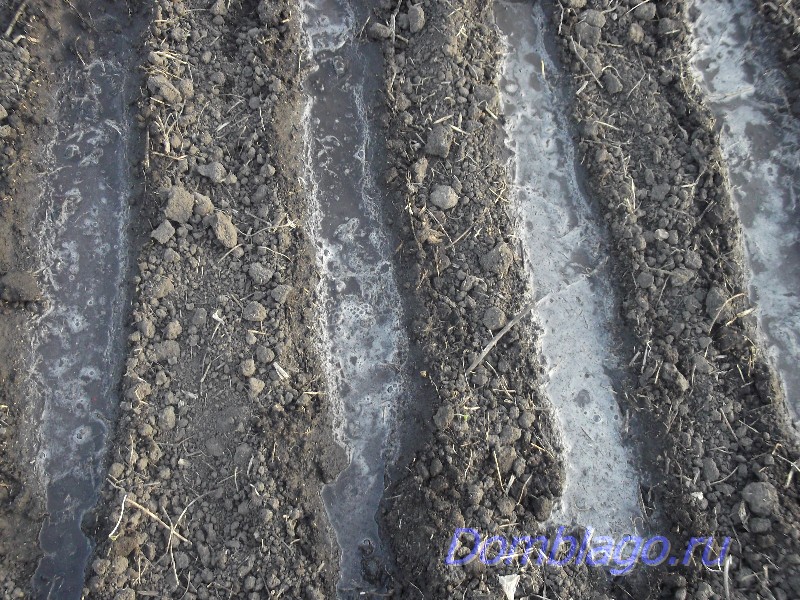
When water is absorbed, I fall asleep furrows ashes. I do not regret ashes, I pour it so that I would get a cinderboard at the bottom of each furrow 5 centimeters high and more.
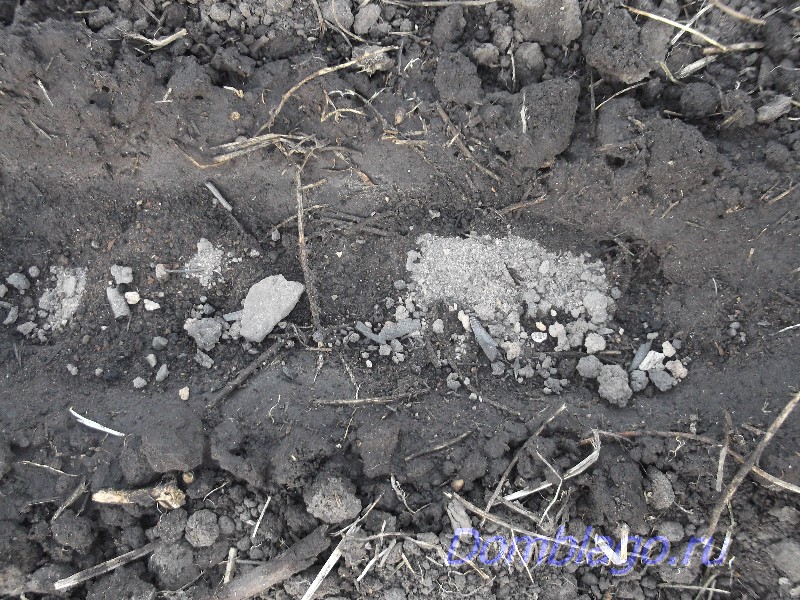
Then, lay out the bulbs, without pressing the bottom, just lay on the furrow. At one meter I have 5 onions.
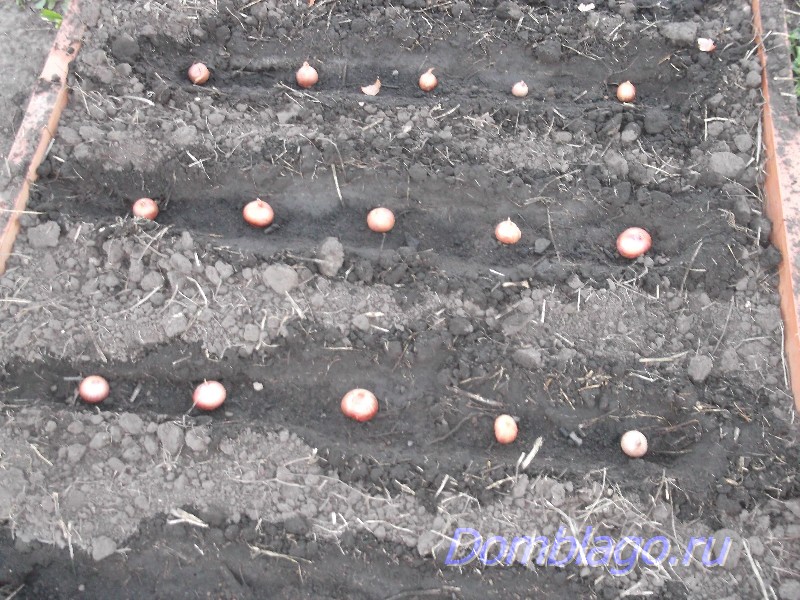
Decomposed onions fall asleep with the ground as if I spud potatoes, while forming high crests.
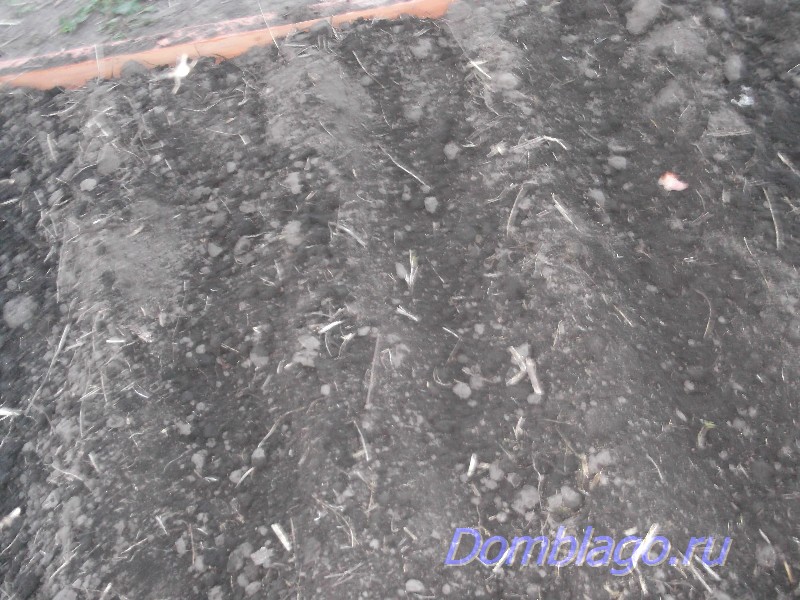
After planting, every three to four days I spend watering, loosening the soil between the ridges, combined with the removal of weeds. After each loosening, you need to update the ridges, pouring the soil from the row spacing to them, I carry out this procedure until the green mass of the onions grows, so that updating the ridges will not be possible without damaging the feather.
From the moment the sprouts appear and before they reach a height of 10 centimeters, you need to choose the time and produce the first additional feeding with liquid organic matter. This may be a solution of fermented grass or a solution of mullein in a ratio of 1: 10.
While the nest begins to form, it will be necessary to carry out one more feeding. The second dressing is made with ashes, it needs to be plentifully scattered between the rows and shed with water.
As a result of irrigation and soil loosening, the ridges gradually become equal to the ground and the onion nests will appear on the surface, which will allow the bulbs to grow and mature freely.
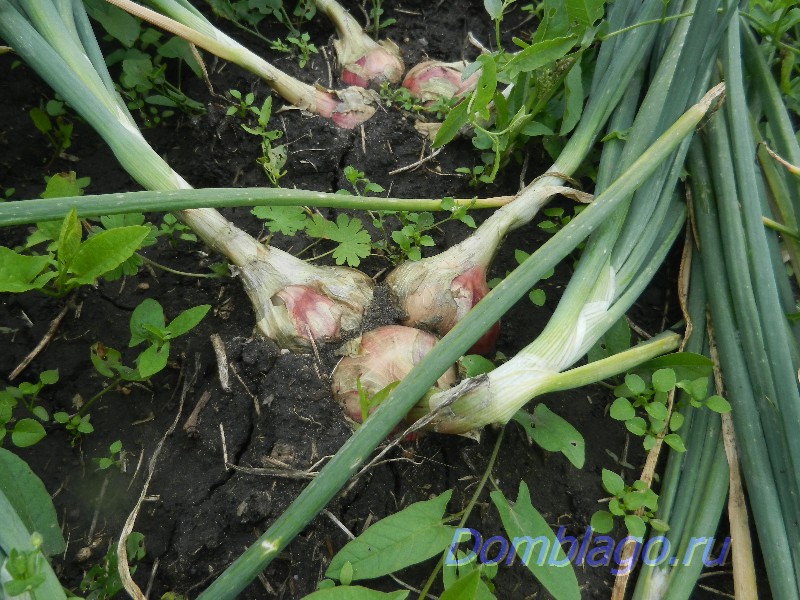
During the entire period of growing a family onion, nests can be thinned out by removing the bulbs from the center. Such bulbs can be used for food, if the neck is thin enough, then they can be dried well and removed until next year for planting.
When the nests grow and the green onion mass closes over the aisles and it becomes difficult to water the plants on the ground, you can stop caring for the onion bed, wait until the onion neck breaks down and start harvesting.
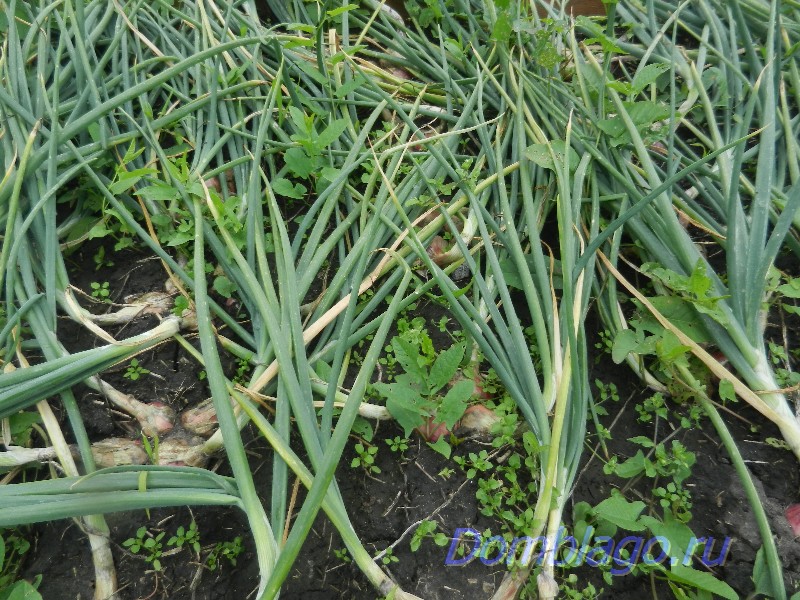
Usually for picking a family onion, I choose a sunny day, carefully remove the bulbs from the soil and leave for several hours on the garden bed to dry. Then I put them in baskets or polymers with bulbs down and put them in a well ventilated place until the feather dries.
To receive excellent yields Onions in the middle lane, you need to know which varieties are optimal for this region. In this zone, you can successfully grow onions and onions on greens.
Instruction
- Climate middle band Russia is moderately continental. There are rare frosts here, and summer is warm and humid. Therefore, in these areas you can plant most of the heat-loving plants, which include some varieties of onions.
- What type of onion grows best in the middle lane? Despite the fact that this vegetable is grown everywhere, some gardeners know little about the zoning of varieties and do not understand why they, with proper care, take a small crop of onions. You should know that most of its varieties are closely tied to the climatic conditions of cultivation. Therefore, the choice of seed or planting for planting should be reasonable.
- The following varieties are most suitable for the middle zone: Terekhovsky, Robusta, Yantarny, Volska, Belovezhsky, Stuttgart, Strigunovsky, Spassky. According to folk omens, onions can be planted at the time when frogs ferment. Experienced Gardeners recommend to focus on the third decade of April. The seeds of this vegetable germinate best at a temperature of 18-20 * C. With greenhouse cultivation Onions cannot be planted in autumn and winter: during this period it is at rest.
- What onions to grow on greens? To get a good harvest and as soon as possible, the seeds and planting need to be planted in open ground in the fall two weeks before the ground freezes. In greenhouses it can be grown year-round. Top Grades onions for greens for the middle band: multi-tiered, slizun, shnit-onions, onions-batun. The most unpretentious is considered multi-tiered. This type of onion can be grown at fairly low temperatures. It is undemanding to the quality of the soil and lighting. You can grow it with the help of bulbballs or underground false bulbs. In the middle lane of planting material can be obtained up to 2 kg of green onions.
- Greens grown from seeds, it turns out weaker. It grows more slowly, it requires more careful care, it withers away faster. For perennial varieties (shnit-onion, batun) seeds are harvested in the autumn. Great yields in the middle lane gives shnit. He has a pronounced aromas and looks very attractive. Therefore, this variety is often grown for commercial purposes.
- How to care for onions in the middle lane? Because the root system of this vegetable is located in the upper layer of the soil, you need to loosen the ridge shallowly. All varieties of onions need regular watering. When landing in open ground in early spring, film coating will be required. Take it off as soon as the weather comes warm. From about mid-June onions on the greens begin to turn yellow. Therefore, it should be removed a little earlier. Choosing a variety of onion suitable for the middle band and proper care for it guarantee an excellent harvest.
KakProsto.ru
Varieties of onions on the pen: description, selection, planting
Bow - herb plant Onion sorts, includes several both edible and decorative species. It is of great importance in cooking and in traditional medicine.
In cooking, the underground part is used - an onion, similar in shape to the turnip, hence the name onion bulb, and ground green leaves, which most often have a narrow, fist or narrow flat shape and resemble long feathers.
Types and varieties of onions for growing on the feather
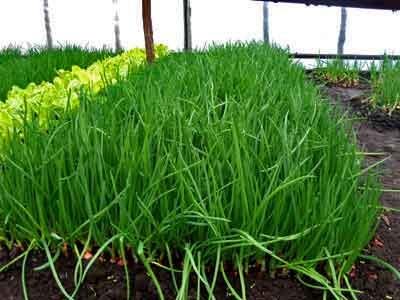
The most popular and widely grown type of onion on the greens is onion batun. It has a well-developed ground part, represented by long tubular leaves up to 1 m high.
The leaves of onion batuna are similar to onion leaves, but exceed it in content of vitamin and nutrients. On one place grows several years.
Onions are grown in two cycles - sowing seeds and planting onions (seedlings).
To produce green onions, you can use both the forcing of the feather from the bulbs and plant special varieties of onions on the feather.
Varieties of onion batun
- The Ural family is a winter-hardy, middle-ripening variety, yields greens 25 days after the beginning of the growth of green leaves. In height reaches from 35 cm to 50 cm, the taste is semi-sharp, the leaves are tender. The variety is productive, yields for the season more than 7 kg per square meter. The variety is frost-resistant, it propagates only by dividing the bush.
- Seryozha - an early variety of onions - batun. It has good winter hardiness. The leaves are straight, gray - green shade, in length more than half a meter. The taste is semi-sharp.
- The seven-year-old is a middle-ripening variety, suitable for cultivation in personal subsidiary farms both for personal needs and for sale.
- Maysky - middle bow onion batun. Good grade both for personal needs and for cultivation in farms for sale.
The main methods of growing batun
Some varieties of onion batun can be propagated by dividing the bush in spring or early summer. The bulbs are planted to a depth of 3 cm, the distance between them is up to 25 cm. The seeds are sown at the beginning of May.
It should be remembered that in 1 g contains about three hundred seeds and crops can be very thick. Therefore, they will require thinning. In July, you can cut the leaves on the greens, they will grow again until the autumn. Autumn greens are not cut.
On next yearas soon as the leaf starts growing, the first crop can be harvested after 25 days, the second - after 55 days.
Bow Schnitt
Schnitt - onions - this is another type of onions that are grown for the sake of greenery, although the food is medium-sized, up to 1 cm in diameter is a false onion. The first green appears immediately after the snow melts and has a very delicate flavor.
Bohemia variety - fruitful perennial chives - onions. Growing in one place to five years. The first cut of greens takes place three weeks after the start of the growth of green leaves.
Chemal - a sharp variety of onions, yields a crop suitable for mass harvesting the following year after planting. Removed completely in the spring. Leave only uterine bushes.
Honey plant - yields a crop about 90 days after the start of regrowth. The taste of the greenery is semi-sharp. Suitable for cultivation in private farms. The technology of growing chives is similar to the technology of growing batun.
In the first years of planting, shnitt - onions need regular weeding, but later form dense turf. Like all onions, it prefers a soil that is well fertilized with organic matter and mineral fertilizers.
Shallot
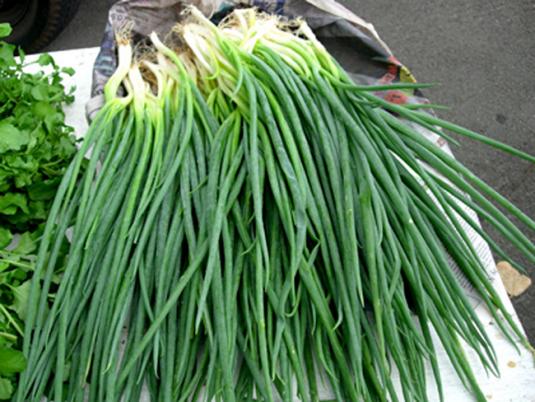
Shallot onions are a type of onion forming many small fused onions, which serve as seed material for the next season. It is grown mainly for greens as a biennial crop. The leaves are cut several times per season.
- Andreyka - mid onion with a semi-sharp taste
- Athos is a productive onion with an average ripening period.
- Bow - Slizun
Onions - slizun grown on greens, which gives almost immediately after the snow melted, valued for being the first vegetable garden.
- Leader
- Broadleaf
- Dwarf
- Belorussian
A distinctive feature of onions - slizuna is the accumulation of mucous juice within the leaves. In the autumn, having dug an onion bush - slizuna from the garden bed, you can transplant it into a flower pot and have a harvest of greens on the windowsill all winter long.
Bear's onion
Separate from the above-mentioned species and varieties of onion is wild garlic, the flat leaves of which resemble onion feather in appearance, and the taste and smell of wild garlic resemble strongly the garlic, although wild garlic is also a type of onion. In the food used young leaves.
All types of onions, which are grown for the sake of greenery, are cultivated mainly in the open field. In closed greenhouses or greenhouses use the method of forcing greens from varieties of onions.
Onion varieties for green feather
Many housewives grow green onions on the windowsill, putting an ordinary onion in the water. A similar technique is used in greenhouses, where they produce onion greens using hydroponics. It is much more profitable planting onions for forcing greenery into the ground.
Greenhouse farms use the one and the other way to get greens from onions. Planting material in this case there will be onions - samples, that is, small bulbs selected from onions - turnips.
The best varieties for this can be:
- Strigunovsky
- Rostov
- Arzamas
- Mstersky
- Bessonovsky
With one bulb, greens can be cut several times, as a rule, they do it two to four times. After which they plant a new batch of bulbs. Cutting is carried out after the leaves reach a length of 35-40 cm.
It should be said that growing onions for greens for sale, both in the greenhouse and in the open field, can become an additional family business, since at any time of the year vitamin greens are in demand among the population.
OgorodSadovod.com
Varieties of onion for the Urals
Good day!
I want to tell you about onion varieties for the Urals. These varieties are included in the state register of the Russian Federation and tested, tested specifically for our climate and light zone. Because different regions receive different amounts of light and heat. The Urals region includes Kurgan, Chelyabinsk, Orenburg regions and Bashkiria. In the description all regions for which these varieties of onions are suitable will be indicated. In order not to list them each time, I will mark them with numbers, as in the registry:
- Northern - Murmansk, Arkhangelsk regions. Komi Republic, Karelia.
- Northwestern - Kaliningrad, Vologda, Kostroma, Novgorod, Leningrad, Pskov, Yaroslavl, Tver regions.
- Central - Vladimir, Bryansk, Kaluga, Ivanovo, Ryazan, Moscow, Tula, Smolensk regions.
- Volgo - Vyatka - Kirov, Sverdlovsk, Nizhny Novgorod regions. Republic of Mari El, Chuvash, Udmurt, Perm Territory.
- Central Black Earth - Voronezh, Belgorod, Lipetsk, Kursk, Tambov, Oryol regions.
- North Caucasus - Krasnodar, Stavropol Territories, Rostov Region, Republic of Adygea, Karchaevo-Cherkesskaya, Kabardino-Balkaria.
- Middle Volga - Samara, Penza, Ulyanovsk regions. Republic of Mordovia, Tatarstan.
- Lower Volga- Volgograd, Saratov, Astrakhan regions. Republic of Kalmykia.
- Ural - Orenburg, Kurgan, Chelyabinsk regions, Republic of Bashkortostan.
- West Siberian - Altai Republic. Novosibirsk, Kemerovo, Omsk, Tyumen, Tomsk regions, Altai Krai, Khanty-Mansi Autonomous Okrug.
- East Siberian region - Chita, Irkutsk regions, Krasnoyarsk Territory. Republic of Sakha, Tyva, Buryatia, Khakassia.
- Far Eastern - Kamchatka, Amur, Sakhalin, Magadan regions. Khabarovsk, Primorsky Krai.
Onion varieties for the Urals with photos and descriptions
Arzamas
This is an old, well-known, time-tested variety of national selection for cultivation in a two-year culture, through sevok. Bulb from elongated-rounded to cubical-rounded. The sizes are average, weighing from 40 to 80 grams. The variety is zoned in the Gorky (now Nizhny Novgorod) region in 1943. The average ripening period is from 100 to 110 days. Medium-wheel, low-fat. Perhaps growing to large bulbs in one year. The color of the scales is dark yellow, even with a brown tint; the scales inside are white, juicy, dense. Ripens before harvesting up to 96%. Well kept in winter.
Growing regions - 1, 2, 3, 4, 5, 7, 8, 9.
Variety "Arzamas"
Bessonovsky local
Early multiyear acute variety. It can be grown in one-year, and two-year culture. Rounded flat bulb, dense, outside scales yellow, inside white. Bulbs grow weighing 36-55 grams. From the germination of the first feathers on the set to their lodging takes 60-80 days. Longevity is good, can be stored almost until the spring - 8-9 months.
Suitable for regions - 4, 5, 7, 8, 9, 10, 11, 12.
Variety "Bessonovsky local"
Buran
Late-ripening variety. The bulb grows single-toed, three-germ. Designed for growing two-year cycle. Universal grade, with a sharp vkusy. Bulbs dense, rounded, weighing 67-100 grams. Dry scales bright yellow with anthocyanin, juicy - white. Yield up to 12 tons per hectare. Before harvesting, maturity is about 63%, and after ripening - 89.2%. Keep well. May suffer from perenosporosis. Yields stable with large even bulbs, with good keeping ability, resistant to bacterial diseases.
I did not find this variety in the State Register for 2015. Apparently, already excluded, but he continues to live as a local variety, spreading by local gardeners.
Zoned by Central, Middle Volga, Ural regions.
Variety "Buran"
Botherus
The variety is medium early. Grown in one year from Chernushki and in a two-year culture. Large flat rounded bulb, weighing 60-80 grams. Outside the scales are yellow, inside are white. Spicy taste. Before harvesting the variety matures by 85%, after ripening by 97%. Suitable for winter storage.
Growing regions - 3, 9, 10 .
Variety "Botherus"
Moldavian
Mid-season breeding variety of the Transnistrian NIISH for cultivation in one season. When planting sevka for the second year goes to the arrow. Ripens in 105-110 days. Flat-rounded or rounded onions, weighing from 70 to 130 grams, under good conditions, up to 200 grams and more. Outside, the scales are pink-brown with a white-purple hue, and inside - pale-purple. Two-chetyrehchatachkovye. Universal purpose, spicy taste. The average yield of 25-38 tons per hectare. When storing the safety of onions 90-95%.
Variety "Moldavian"
Myachikovsky 300
An early variety from full shoot from planting to lodging a feather takes only 80-90 days. Medium density, flat or onion, weighing up to 110 grams. On top of the scales are yellow, and inside - white. Low-grade variety, multi-purpose, semi-sharp taste. Well kept in winter. Suitable for growing seeds for one year.
Variety "Myachikovsky 300"
Red baron
The variety is suitable for cultivation, as seeds in one season, and Sevka for two years. The bulbs are dark purple completely, both from above and inside. The period from the first green feathers to their lodging is 95 days. Rounded flat bulb weighing up to 120 grams, semi-sharp taste. The yield is usually 1.5 kg / m. Onions scales dense, strong, recommended for long-term storage.
Suitable for growing in regions - 3, 4, 5, 6, 9.
Variety "Red Baron"
Siberian Annual
Superearly variety. When planting from sevka ripen for 60-70 days! If grown from seed, then on a 90-100 day! A lot of green, feather blue-green color. Flat or flat-round bulb, yellow. Semi-sharp taste. The weight of the bulb grown from the seed reaches 200 grams, from seeds with an annual crop of up to 100 grams. The variety "Siberian Annual" is well preserved, resistant to leveraging.
Suitable for growing by region – 4, 9, 10 .
Sort "Siberian Annual"
Strigunovsky local
Early sharp variety. Suitable for cultivation for the year and the biennium from the sevka. Dense bulb is roundish, chetyrehchatchatka, weighing 45-80 g. Outside the scales are yellow with a grayish or pink shade, inside are white. The variety is valued for its good winter maintenance. Through sevka, the variety ripens for 80-90 days, from seeds when sown in early spring or before winter - for 110-130 days.
Suitable for growing in all regions of the Russian Federation.
Variety "Strigunovsky local"
Black Prince
Mid-season variety (100-105 days), created VNIISSOK. Suitable for sowing before winter and in early spring (one-year) and growing through onion sets (two-year). Rounded, dense onions, weighing 60-100 g. Purpose is universal. The scales are dark purple. Two-three-wheeled, low-graded variety, of semi-sharp taste. Productivity up to 50 tons / ha. Good quality.
Variety "Black Prince"
Exibichen
Medium late grade. Very fruitful, cold-resistant variety designed to obtain full onions in the annual crop. Valued for high yields in different climates. Beautiful, dense oval bulbs grow up to 800 g during the summer. The upper scales are straw-colored, white inside. Surprisingly juicy, sweet variety. Disease resistant.
Suitable for growing in all regions of the Russian Federation.
Variety "Exhibition"
Timiryazevsky
The old variety, which is no longer in the state register, but it lives in gardens. Zoned in 1968. Early, low-fat, low-starter. Designed for growing from seed in a two-year culture. Flat-rounded onion, dense, spicy taste, weighing 50-70 grams. Outside the scales are light brown, sometimes yellow, inside are white. Maturation depends on the weather from 65% to 100%. The stability is good up to 95%.
Suitable for growing in regions of non-black earth: Ural, East and West Siberian, Volga-Vyatka.
Variety "Timiryazevsky"
These are all varieties that I found in the State Register for cultivation in the Urals. There are more hybrids there, but I do not plant them myself and I will not recommend it to my readers.
The best varieties of onions "not for the Urals"
There are still popular varieties that, despite the registers and recommendations of academicians, the gardeners of the Urals grow on their plots. They spread themselves, thanks to their popularity.
Danilovsky 301
"Agrofirm Aelita" and VNIISSOK. Mid-season variety, low-fat, low-starter. From the mass appearance of green leaves at the sevka to lodging takes 90-100 days. The bulb is flat-rounded and flat, weighing from 80 to 160 grams, spicy taste. Outside, the scales are dark red with a violet tinge or violet, and inside - light violet. The yield of varieties of seed from 12 to 33 tons / ha.
Variety "Danilovsky 301"
Karatal
Selection of the Kazakh Research Institute of Agriculture. Early variety, ripening for 109 days. Recommended for cultivation as one-year. The bulb is usually round, sometimes flat, dense, weighing 120 grams. Small onion. The average yield is 4.4 kg per meter. The scales outside are golden yellow and the inside is white. The grade of pleasant semi-sharp taste, is intended for the use fresh and for processing. His balance is satisfactory - a C grade. The variety is stable, productive, with large bulbs of good quality . Onions are intended for cultivation in one year from seed.
Variety "Karatal"
I didn’t exclude it, as it became widespread not only in the recommended regions, but also in the Urals. With early sowing under temporary shelter gives good yields in the Ural region. The variety is mostly salad, pleasant semi-tasting. In the second year, it should not be planted with a sevka; it will go to the arrow.
Carmen MC
The variety is medium late, from the appearance of mass shoots from seed to lodging of feathers, it takes 120-140 days. It is intended for receiving a harvest for one season from seeds in an open ground or seedling. The bulbs are rounded flat, aligned, weighing from 90 to 100 grams. Dry scales are purple, juicy - white with a violet hue. Refers to salad onions - semi-sharp taste, almost sweet. Receiving very large bulbs is possible when grown through seedlings. The average yield of 3-4 kg / m. The variety matures well and is suitable for storage, but its main purpose is fresh and for processing.
Growing regions - 3, 5, 7, 8 .
Variety "Carmen MC"
Rostov local
Early local old variety bred in the Yaroslavl region. The best bow for northern regions of Russia. Grown from sevka in two-year culture. Acute early-ripening variety - ripens in 73-93 days after the first green feather. Flat-rounded onion, golden yellow, weighing 30-60 grams. Stored all year, until the new harvest.
Variety "Rostov local"
Odinovets
Mid-season variety (105-120 days). Small, three-stalked. Suitable for cultivation per year and in biennial culture. Flat and ploskookrugly bulbs, dense, weighing 60-80 grams, semi-sharp taste. The upper scales are golden yellow, white inside. Good fresh and for storage, has a good keeping quality. Universal purpose. Valued by the safety of turnips and onion seedlings in winter without loss of quality. Suitable for forcing the pen.
Variety "Odinovets"
Chalcedony
Medium late variety (up to 114 days). Bulb round, spicy taste, dry scales bronze color. It grows very well and is stored throughout the winter. As turnip, and sevok. Purpose is universal.
Growing regions - 6, 8.
Variety "Chalcedony"
Stuttgarter Riesen
German early sharp variety, for a two-year growing period. Purpose is universal. The bulb is flat, dense, weighing 50-90 grams. Outside the scales are golden brown, inside are white. The ripening of the variety to the beginning of the harvest is 55%, after maturation 96%. Well kept. Productivity from 10 to 35 tons / hectare. The variety is susceptible to diseases of cervical rot, and can also be greatly affected by downy powdery mildew.
Regions for growing - 3, 4, 7, 11.
Variety "Stuttgarter Riesen"
This variety is surprisingly popular. Five years ago, we had no other in the market. Apparently, his popularity is based on early ripeness. But it gives good harvests only on rich, very fertile land and in favorable conditions. If it rains all summer, (and we have such weather, despite the hot years and global warming), then you can lose the entire crop, it just rot and will not be stored, even after drying.
About ten years ago I grew only this variety and I remained without onions for the winter. All July it rained and had to be cleaned in such weather. How then I did not dry it, anyway rotted. Therefore, the choice of varieties must be approached responsibly, our crop depends on it.
These are the varieties of onion for the Urals and other regions turned out today in the article.
belochka77.ru
onion variety
✿Elena m✿
For the cultivation of green onions on the pen use different types of perennial onions, onions and shallots. If the onions on the feather are grown in a protected ground, then only varieties of onions are used.
The best for forcing the early green feather is shallot.
Shallot - polygamous, multiply onions. Reproduces usually vegetative way. Each bulb planted forms 5 bulbs and more. The varieties of this onion are the earliest ripening and give a high yield not only of turnips, but also of green feather. The best varieties of shallots are as follows.
Kuschevka Kharkov. The variety is bred by the Ukrainian Research Institute of Vegetable and Melon-Growing. Yielding and very early: from shoots to ripening of the bulbs 70-78 days pass, and the green feather ripens in 30-35 days. Bulbs of irregular shape, weighing 35-40 g, sharp taste; dry scales are brown with a violet tinge; juicy ones are light purple. In the nest is up to 6-8 bulbs.
Onions on the feather are grown on well-fertilized areas. For this purpose, rotted manure is brought under the autumn plowing - 40-60 t / ha. The bulbs are planted in the spring in the earliest terms on irrigated lands, and in the Odessa, Kherson, Nikolaev and Crimea regions - before winter. Planting methods: band, according to the scheme 50 + 20 cm, or single-line, with 45 cm row spacing. In a row, the bulbs are placed at a distance of 5-6 cm from one another. Planting depth of 7-8 cm. Plant care is weeding, loosening between rows and watering. Harvesting the green feather is carried out as needed, approximately 30-40 days after planting, when the feather grows at 20-25 cm.
On taste distinguish sharp, semi-sharp and sweet varieties of onions.
Sharp varieties of onions
These varieties of onions are more early, but less fruitful. Their bulbs are very dense, many dense surface scales. Due to this, these varieties are very well stored, less damaged during harvest.
These include the following varieties: Arzamas local, Bessonovsky local, Apogee, Aleko, Borodkovsky, Golden Semko, Golden domes, Robot, Rostov local, Spassky, Strigunovsky, Stuttgarten-Rizen, Yukont, Amber, M, etc.
Semi-sweet onion varieties
Semi-sweet varieties ripen longer, are more productive. The bulbs are more juicy, less dense, superficial scales dense, but they are smaller, due to this their keeping quality is average and you need to be more careful when harvesting so as not to damage the bulb.
These include the following varieties: Alvina, Danilovsky 301, F1 Durko, Zolotnik, Globus F1, Albion, Wellington, Kaba, Carmen, Krasnodar, Myachnikovsky 300, Odintsovo, Olin early pink, F1 Reddon, Black Prince, etc.
Sweet Onions
Sweet varieties produce high yields, but more often they are medium to late ripening, so they are better ripened in the southern regions. They have good taste, the onion is not so dense, the internal scales are thick, juicy. The upper scales are thin and not many, so these varieties are poorly stored. When harvesting the bulb is easy to damage.
These include: F1 Comet, Exhibit, Retro, Spanish 313.
In terms of the growing season, varieties are divided into early ripening (55-110 days), mid-ripening (85-130 days), middle-late (105-140 days), late-ripening (110-175 days).
Brief description of some varieties of onion seedlings
Annual Siberian. Early. The shape of the bulb is rounded-flat. The color is yellow with a pinkish tinge. The inner scales are fleshy, white. Mass ~ 30-60 gr. Sleepy, semi-sharp.
Strigunovsky. Early, round shape, sharp, M ~ 45-100 gr. When growing requires abundant watering in the first half of the growing season, otherwise it will be small and bitter. The color is yellow, the inner scales are white. Small-class
Bessonovsky local. Early, sharp, well kept, 3-5 bulbs in the nest. M ~ 35-65 gr. Urozhayny, the shape is rounded flat,
Arzamas local. Mid-season, sharp. The color is dark yellow, the inner scales are white, juicy. In the nest there are 2-4 bulbs. M ~ 30-90 gr. The bulbs are dense, well kept.
Timiryazevsky. Early, sharp. The shape is flat-rounded. In the nest of 1-2 bulbs. M ~ 60-70 gr.
Ellan. Winter variety. Early, Resistant to many diseases. Form-rounded, M ~ 100-120 g. Planted for the winter ripen in June, not picky about moisture. has a sweet sweet taste. Used in the summer-autumn time. Stored approximately 6-8 months.
For winter varieties with similar characteristics include varieties of Shakespeare, Radar.
Red Baron. Medium ripe, semi-sharp, flat-rounded, reddish bulbs. Semi-sharp M ~ 130-150 gr.
Carmen Mid-season, semi-sharp. The shape is rounded flat purple color. M ~ 100-120 g, well kept.
Stuttgarten - Riesen. Early, sharp. The bulbs are flat-round, golden brown in color. M ~ 100-150 gr. Stability 6-7 months.
Danilovsky 301. Mid-season, semi-sharp, small-nest. The bulbs are flat-rounded, from dark red to purple. M ~ 100-150 gr.
Golden Semko F1. Early maturing, semi-sharp. Bulbs flat-rounded shape, golden brown. M ~ 80-100 gr. Well kept. Its main advantage in complex resistance to almost all diseases of onions.
Centurion F1. Early, sweet, M sometimes reaches 200-300 grams. Also resistant to most diseases of onion, well kept. Requires very good drying, because the neck is thick.
Onion varieties zoned for Siberia
Annual Siberian, Strigunovsky, local Bessonovsky, local Arzamas.
Choose a variety of onions to taste, by climate, by purpose. Experiment and share the results.






